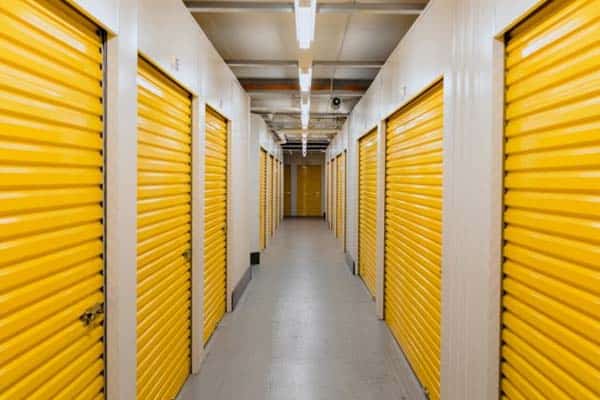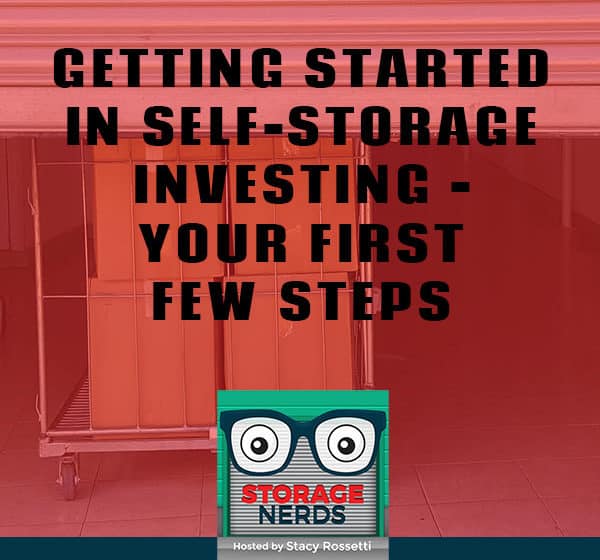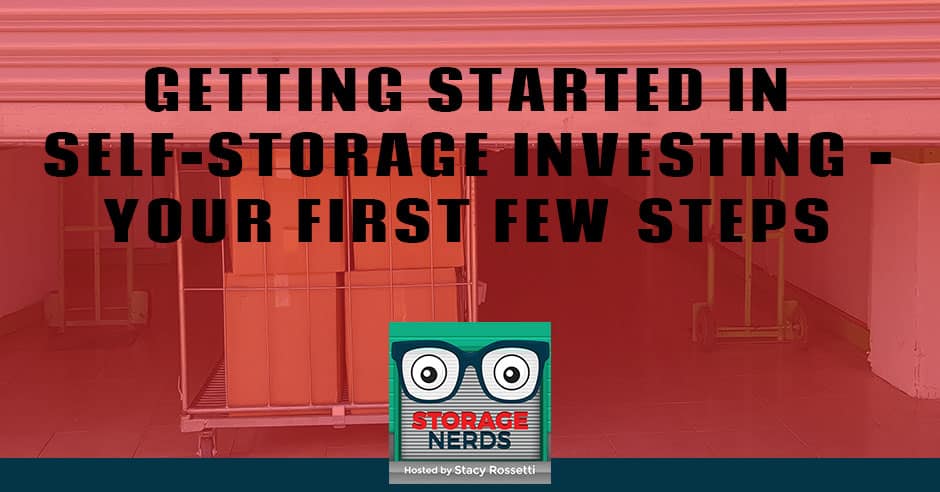Over the years we have seen diversity in real estate investments. And one liquid space is self-storage. So if you are looking to invest in storage and want to get a good headstart, don’t miss this episode of Storage Nerds. Stacy Rossetti shares valuable tips on how you can buy a self-storage facility within the next 90 days. From finding the facilities, qualifying the market levels, and how to leverage your team and their training in scaling your business. Tune in and learn business strategies to jumpstart your portfolio and get that cash flowing in.
—
Watch the episode here
Listen to the podcast here
Getting Started In Self-Storage Investing – Your First Few Steps
I’m going to do something super-duper easy in this episode and not getting anything is too difficult because my brain can function that well. I figured we would get into like Self-Storage Investing 101. How to get started? I’ve had a couple of people comment that I haven’t talked about how to get started lately. I’m always talking about deal analysis or owner financing. In this episode, we would do some easy stuff like how to get started. Self-Storage 101 is what we’re going to do. That way, I can let my brain rest for a minute.
I teach every Monday and the title of this is How to Get Started in Self-Storage Investing or How to Buy Your First Facility in the Next 90 Days. The truth is that you can’t learn how to invest in self-storage in one hour. If you’re a newbie here and you haven’t gotten into self-storage investing and you’re learning, know that I’m here every Monday night and I teach for free to anybody that wants to learn.
There’s a new topic every Monday night. If you continue to come to this session, over time, it will start clicking. Learning how to invest in self-storage is something that you have to work at. I had a couple of comments about that. I wanted to point that out. A couple of people were like, “You’re not talking about what your title says.” That means I have to change my title every single week and that’s too much work.
The title is How to Get Started in Self-Storage Investing and How to Buy a Self-Storage Facility Within the Next 90 Days. Every Monday night, I’m going to be teaching you something about self-storage investing. That’s the big point that I wanted to point out. A lot of people come every Monday night and you come whenever you want. This also gets put onto my YouTube page. I’m trying to grow my YouTube page so if you could go and subscribe, that would be awesome.
Not only do I have my show there, but we have all kinds of other stuff there as well, too. We’ve got all kinds of different videos and training sessions on learning how to invest in self-storage. That’s another place where you can educate and learn how to get started. I teach every Monday night, and that goes onto YouTube. Also, I do a bunch of other videos as well, too. It’s not just this session.
The key is in the follow-up. You’re may not get something the first time but if you keep following up, you’ll get something.
The Super Simple Self-Storage
Before we get started, I have a quick reminder. You have access to my course, which is called Super Simple Self-Storage. If you need help outside of all the free stuff that I do, then you can get the course. The course has over 100 videos condensed into step-by-step instructions. First, do this, then do this and this. If you want to do it on your own and learn step by step how to do it, I highly recommend that you check out the course. You can find that on my website, which is StacyRossetti.com. On my website, there is a lot of good information and things that everybody should be checking out. I wanted to make sure that you guys all knew about this.
The StorageNerds Coaching Program access is here. If you want to get into the coaching program, the coaching doors are going to open in September 2022. You would get onto the waitlist and then you can talk to me in the first week of September. The door is only open for six days and then whoever’s interested, we can talk and see if it’s a good fit for you. You can check that out. We also have more free training and stuff like that.
REI USA
This is the investor session. If you’re interested in investing with me, you can click on the Investor tab and you can become a private lender or you can invest in my fund. I pitch my fund right after this. You can go to StacyRossetti.com/fund and it will take you to the registration page where you can hop on to the pitch that I do every Monday night. There is also access to REI USA. I own REI USA. It’s an online education platform for real estate investors. If you want to get into real estate investing, not only in storage but also in Airbnb, land, rehabbing, or wholesaling, this is what we teach here. We also have the information about the next bootcamp coming up.
Finding Storage Facilities For The Right Price
You’ve been to this website before, too, because this is where you register. We always have two sessions up so you can register for the next two sessions of this webinar. I teach something different every single Monday night. That’s available to you. I wanted to show that to you guys. The point of this session is to get you guys out looking for storage facilities, where you’re looking for a storage facility.
If you guys are all new and haven’t been here before, welcome. I teach in three sections. I teach Find Them, Fund Them, and Run Them. I was thinking about going over the most important points of all three of those sessions. Those sections are what I was going to do. The first is to find them. You guys can help me as well, too. If you have other ways to find storage facilities, let me know. I was going to list out the ways that we’re finding storage facilities.

For those of you that don’t know, I have fifteen virtual assistants that work underneath me. My acquisitions manager is Chris. He is training them and teaching them how to find facilities. I’m struggling with this. When you get out there and look for owners, because of how volatile the market is moving, I feel that we should be offering a higher cap rate and a lower price for our storage facilities. What I’ve noticed though is that a lot of owners are not open to that.
You guys tell me if you think this is going to happen, but I want to get back to pre-COVID time. I would put an offer in and the owner would be willing to negotiate with me and talk to me. I feel like the last few years convoluted a lot of owners’ mindsets on what they think their facility is worth. They’re pushing super high prices and low cap rates.
For instance, in Texas and tertiary markets, people are wanting a 4% or 5% cap. A 6% cap would be a good deal in Texas. The market is volatile now. I feel like we’re coming off of a high, but a lot of people are still reluctant to let go of those high prices. I personally know where the market is going to go and where the market should be. I’m only offering what I feel the property’s going to be worth in the course of six months or a year, but the sellers are still not thinking that.
The sellers are still thinking that we’re on this high price selling point. Keep that in mind. It’s rough to find people. Our VA’s job is to find owners that want offers and make offers. What we’re finding is that owners want offers and we’re giving them the offer based on what we feel the number is worth, but they’re not wanting to take that. We’re working with my students to get to that point where you feel comfortable.
Cold Calling Around
What offer do you feel comfortable with versus what the seller feels comfortable with? We’re trying to work that out. I feel that it’s still like a little bit of a headbutt. Be aware that it’s a little bit more difficult to find sellers to get the right price versus what it was before, but it is getting better. We are making a lot of offers, a ridiculous amount of offers, but getting the right price is the hard part. Be aware and be conscious of that. What we’re doing personally is we are cold calling.
The hidden market is all those facilities that are not on Google Maps.
I’ve been doing this for five years. Our VAs go onto Google Maps, find facilities, call them, and see if they want to sell. There’s a huge difference between facilities where the owner answers the phone and the manager answers the phone. You want to find facilities where the owners answer the phone because the manager is like a roadblock. This is one of the ways. We’re getting on Google Maps, creating a list of facilities in the area, and cold calling.
After they get 300 names, they start calling twenty owners a day. Their job is to make one offer a week. We’re out there. That’s why we have so many offers. It’s a full-time job for them to call. They also work as the lead and try to get all the information from the owner. We’ve found that this is the best way to find deals. If you don’t want to be the one that cold calls, you could always hire a virtual assistant to do that. This is the way that I found to find the best deals outside of my way, which is driving for storage.
Meeting The Owners
The best way to find deals is to meet and talk to the owner. The owner wants to know, like, and trust you. For all of the fifteen states that we’re working on, when we find a good deal, we know the owner wants an offer, but we’re trying to still come to terms with what it is. We send over the student to go and meet the owner. Going, talking, and meeting the owner is going to be one of the best ways to get the deal.
I live in an RV and travel full-time so it’s hard to make a meeting. If they want to hop on Zoom, I’m going to hop on Zoom. I’m doing meetings all the time with owners. If you are living in a different state and looking for facilities in another state, then please offer Zoom. Say, “I’m interested in your facility. I can’t come there because I live in another state. If we get it under contract, I’ll come over there and take a look at the facility but now, I can’t. In the meantime, I would love for you to hop on Zoom so that way we could talk face-to-face and try to work this out because I’m interested in your deal.”
The owners that hop on Zoom and meet you are the ones that will always work with you. I’ve never met on Zoom an owner that’s like, “I’m not taking your offer.” The ones that will hop on Zoom are the ones that want to work with you. Try to get them to meet in person if you can if you’re looking in your area within a couple of hours of a drive. If not, you need to hop on Zoom and introduce yourself.

We do a lot of cold calling, but our cold calling is only to get the foot in the door and talk to the owner. They say, “You do want an offer. We’re going to work on getting you an offer. Why don’t you meet Stacy in the meantime? Talk to Stacy and see if we can work this out.” From there, if we can work it out, then I bring the student in, and then the student gets to meet and talk to the owner. They can go over there, drive there, fly there, or do whatever they have to do.
Searching Through Google Maps
That’s how we’re working it. It’s going well. I wanted to show you what we were doing to find our facilities. I personally still love driving for storage and talking to owners directly. Since I’m in an RV traveling, the next thing I use is Zoom and have my VA’s all doing cold calling to get our foot in the door. If you guys have any other ideas about finding deals, let me know what you guys think, but that’s what we’re doing. All you have to do on Google Maps is to search for storage in your area. You just go onto Google Maps, and in whatever area that you’re interested, search storage.
A couple of my students and VA’s are using Google Earth. They like Google Earth better than Google Maps, but either Google Earth or Google Maps, you search nearby storage. You could search warehouses. See what comes up for warehouses. After you do that, you start making a list of everything that you find. On the list, essentially, we’re not just making a list of the name of the facility. We’re making a list of the name, the address, city, state, phone number, and how many reviews and stars they have. Do they have a website? When we call them, we list out the owner or manager. Who’s calling?
Sorting Your List
Another column that we do make on our contact list was secondary, primary, and tertiary markets. If you find a facility in a tertiary or secondary market, you want to keep that. You want to know when you look at your list because on our sheets that we have or on all of our lists, we can sort by tertiary market. Essentially, we can sort tertiary market owners that answered the phone and all these names will come up. We could call each one of those and see if anybody’s available. We can search for secondary market owners and then we could call all those.
Be cognitive about how you list all the facilities that you find. You’re going to want to have some master lists where you’re keeping track of all the facilities that you’re calling because the truth of the matter is that the key is in the follow-up. You’re not going to call and get something the first time. You are rarely ever going to do that. If you keep following up, then you’ll get something.
Anybody can learn cold-calling skills. If they’re not doing well, that’s because you’re not training them properly.
The Hidden Market
Another thing that’s important is the hidden market. I’ve talked about this many times before, but the hidden market is all those facilities that are not on Google Maps. These are important facilities because they have not gone through the process of getting on Google Business listings. It is the listing that you manage for your business and helps you to show up on Google Maps. There are millions of businesses that are not on Google Maps.
For storage facilities, there are a ridiculous amount of storage facilities that are not on Google Maps. Trying to find those are the hard part and I do that by virtually driving for storage. When you’re on Google Maps searching around and trying to find facilities this way, you can search nearby and look for facilities. Search Google and look for facilities that are not on Google Maps. There are a lot of videos on YouTube where I go over this. You could check it out there.
These are the VIP facilities because these people have not figured out how to get on Google Maps. All the newer facilities are on Google Maps, but the ones where owners have owned them for 10, 20, 30, or 40 years before Google Maps was even around, they’re not going to sit there and try to figure out how to do all that. Those are the good deals to find and you can most likely talk to the owner.
These are some of my favorite ways to find them. You can look in Facebook groups, the MLS, Crexi, or LoopNet but we don’t do that. We are grassroots all the way. We talk to the owner directly. We don’t go onto Crexi and LoopNet because that’s where everybody goes. We want to talk to the owner directly because that’s where you get the best deal. This is what my VAs, my team, and my students do. They’re talking to the oldest directly.
What Good VAs Do
Somebody asks, “Have you ever felt hesitant to have VA make the calls because you feel that you may be able to make a better connection with the owner as the expert? How do you overcome that?” We have fifteen VAs that are making calls every day. Twenty calls times 15 is 300 calls a day that our VAs are doing. Every day I would say they get a couple of warm leads when they call. They get one warm lead and then every week, they get maybe one hot lead. We do warm leads, which is like, “Maybe one day, call me back in a month or something like that. We’ve got hot leads like, “I would like an offer. Send me an offer.”

They have no qualms. We just had one. The key to getting a VA to make cold calls is training them. Your employees are only as good as you, the leader. If they’re not getting any deals when they’re on the phone, that’s because you suck at training. That’s what it is. Anybody can learn the skill. You’re calling and talking to people on the phone and you’re connecting. I know because I’m seeing it every day with fifteen Filipinos who are calling and making offers. We’re training them.
One thing that I told Chris was, “If they’re not doing well, that’s because you’re not training them properly.” We need more training. We need to get them better on the phone. It doesn’t happen immediately. It could take months for them to get better, but you got to train them. It’s like teaching the students. You can’t expect them to know what to do. As the coach, I’m the one that’s held responsible for how successful my students are.
I have to be a better coach and teacher if they’re not finding deals. I don’t have any problems with them. We had one guy. I’m sure this is typical especially in tertiary markets. A lot of people in tertiary markets have never talked to anybody outside of the country. They just haven’t. Sometimes they are reluctant to talk to people from outside the country.
We had one guy right here. We’ve made an offer. We’re working on our fourth offer now. I made one offer and he said, no. He said, “I want way more than that.” We sent another offer and he said, no. We made one more offer and I said, “Why don’t we send over the student to come and meet him?” He did. The student went over and met the owner and the owner told us the third offer is okay. Now, we’re getting somewhere. We’re getting closer because the first offer was $600,000.
That was at an 8% cap or 7% cap. It’s in Texas. He wants a 5% cap and we’re at a 6% cap. We’re in the middle right there. I talked to the student and I was like, “Are you okay with a 6% cap because this is where he wants to be? Go over and meet this guy and talk to him.” He went over and he talked to the owner and the owner was like, “I’m so glad that you came over here because I’ve been talking to this Filipino on the phone. It’s hard to understand what they’re saying. That happened, but he still took her offer.
Pick and choose what you’re good at and scale up on the things that you’re not good at.
She still is working with us and taking their offers. This guy had never been 20 miles outside of where he lives in the middle of Texas and the little tiny town. He was one of those types of people. It’s good that he did work with this person because I’m sure he’s never done that before. He told the student that it was hard to understand this person. He is like, “I do want to sell my property so that’s why I’m continually working with you guys.” You have that, too.
You can always do better, but you have to do other stuff. You’ve got to find the money. You’ve got to run your facilities. You’ve got all kinds of stuff to do. You have to pick and choose. Maybe your skill best is negotiating contracts, talking to owners, and finding facilities and then you hire somebody to do the running part. You’re like, “I would rather be finding the facilities and this person could be like the boots on the ground person.”
The truth of the matter is that you can’t do everything. If you’re doing it all, that means that you’re overleveraging yourself, and you’re not going to be able to like scale up. Owning one of these things is not going to make you rich unless you have like $3 million and you can go out and buy. I have one student who bought 3 facilities with 630 units. She bought it for $3 million and it got valued at $7.2 million.
If you have a couple of million dollars, you can double the value. If you’re going to buy something for $500,000 and double the value, a $1 million-dollar property is not going to like make you wealthy. There’s maybe a little bit of cashflow or maybe some appreciation on the backend, but you got to have several of these. Pick and choose what you’re good at so that you can scale up on the things that you’re not good at.
Cold Calling Scripts
Somebody asks, “Do we have scripts for cold calls?” Yes. Everybody in our team does their own thing because they all have their own groove, but they’re asking the same thing over and over. They’re asking, “Do you want an offer?” They’re not asking, “Do you want to sell your facility?” because the answer is always no if you asked that. The question they’re asking is, “Do you want an offer?” We’re sending out lots of offers.

People want an offer and we’re like, “It’s a free offer. See what your property is valued at.” Some people will send the offer out and then we’ll never hear from them again. They’re like, “That’s what it’s worth. Thanks.” Some people counter back and say, “I want this.” Some people will come back and be like, “I didn’t even think it was that much.” Make offers. That’s what you want to be saying on your cold calls.
What qualifies as a primary versus secondary versus tertiary market? The primary market is going to be in a major city. Primary market is going to be like Nashville and even the suburbs of Nashville, Orlando, Austin, and Houston. All the major cities and all the suburbs of the major cities are primary markets. For me personally, I describe secondary markets by population.
It’s not population based on being a suburb of a primary market. I say suburbs of primary markets are primary markets. I like towns that are 25,000 to 100,000 people that are standoff. In your state, there’s always these little towns that are 10,000, 20,000, 30,000, 40,000, 50,000, 60,000 or 70,000 people. Those are good secondary markets as long as it’s not a suburb of a primary market. The tertiary market could be a suburb of a secondary market. A tertiary market could be a suburb of a secondary market because those are smaller towns that are up and coming. A tertiary market could be a little tiny standalone city that has less than 25,000 people.
The primary market would be cities greater than 100,000 people. In my mind, I’m thinking of Savannah. If you get into a city and search for storage, all the REITs like new hall, extra space, public storage, and all these come up, that is a primary market. If you see a lot of facilities that are 2-story and 3-story 1-building facilities and stuff, that’s a primary market. You can’t build a three-story building in a small city or something like this. Typically, the smaller studies are going to have smaller facilities.
The primary market is big cities and suburbs of big cities. In a secondary market, the population is 25,000 to 100,000. It’s standalone cities in your state. Also, there are no REITs. If it’s 100,000 towns, there might be a REIT in there. For instance, we own a facility in Valdosta, Georgia, which has 80,000 people and there’s one CubeSmart there. To me, that would still be considered a secondary market. In the larger secondary markets that are 75,000 to 250,000 or something in population, you’ll see these storage facility players that are not REITs, but they’re franchises or something like this.
You don’t ask if the owner wants to sell their facility because the answer is always no. Instead, ask if they want an offer.
For instance, one of my students said that a franchise that has facilities in ten states called her and asked her if she would be willing to sell her facility. In secondary markets, you see these franchises that own a whole bunch of different facilities, maybe along the East Coast or in the Midwest. They have 100 or 200 facilities. They’re not REITs. They’re not huge big players, but they’re smaller secondary players. Keep your eye out for that too but that is not bad. Bolt Storage is a huge big one or 10 Federal Storage. They are huge big players and our competition. We’re in secondary and tertiary markets and some places, too. You’ll still have them as competition. They’re smaller players, essentially.
The tertiary market is the country. It could be less than 25,000 population. It could be in the suburbs of secondary markets or they can be country or small towns in the middle of the country. That would be primary, secondary, and tertiary markets. We own in the primary market, too, because we bought several. We have 1 in Newnan, Georgia, and 1 in Fayetteville, Georgia. When we bought them, they were considered country but now they’re not country anymore because it’s booming. I would consider Fayetteville, Georgia a primary market. We keep track of all of our competition.
It’s so funny. There’s us and it used to be a little tiny and smaller players around us on Fayetteville. Now, all of those smaller players like us have all been bought up by the REITs and stuff. I would consider that facility a primary market. The other one is everything else, either secondary or tertiary markets. We bought that a few years ago. Nobody wanted to be in storage years ago. I was in storage and people are like, “What? Storage? You are crazy,”, but now everybody wants to do it. That was a good buy.
That’s why I said suburbs of secondary market. Secondary markets are good, but if you can’t afford a secondary market, look at the suburbs of the secondary market. Those are also good smaller facilities to get your foot in the door. Over time, if you hold on to that for five years, those cities will boom. Augusta, Georgia used to be this tiny city and it’s booming everywhere now. That is why I like those.
Does Distance Matter?
Does distance from a REIT storage matter to you in areas with straw and primary markets is the point where it makes sense? You heard me talk about Fayetteville, Georgia. It is like a suburb of Atlanta. I would have considered it a secondary market, but over the course of the last few years, it’s moved into a primary market. There weren’t any REITs around a few years ago around Fayetteville. Maybe in the downtown area, there were a couple of them, but where we were, there were no REITs and now, they’re everywhere. They came in and took over. Those are the primary, secondary, and tertiary markets. We talked about finding them.

Driving For Storage
I am living in an RV right now and traveling around. This is how I find storage facilities in an RV. This could be a whole session, How I Find My Storage Facilities While I’m Living in an RV and Traveling Full-time? The one thing I don’t like living in an RV is not knowing whether or not the internet is going to be good. We paid for this ridiculous internet so we can make sure we have nice internet but every once in a while, the internet sucks and it’s annoying. That’s the only thing I don’t like about living in an RV. Other than that, it’s been a blast because we’ve been traveling around, spending time with each other, and seeing the sites and stuff.
We drive all over the country. You guys know how I find my facilities driving for storage. All I’ve been doing for the last year is driving for storage. We found so many facilities. I have one VA that works directly for me. All she does is follow me around my route. We came from Glacier National Park and drove down to Bozeman. There’s no highway to go that way. It’s all back roads and stuff. As you drive these back roads, we found so many storage facilities.
We’re not on the highway. We drove from Bozeman to Custer and most of that was Highway 90. We found hardly any storage facilities during this time, but that was okay because we were sick and I was not even in the mood anyways. From Glacier to Bozeman, we drove the back roads. It was a four-hour drive and we found at least 30 or 40 storage facilities. We’re driving for storage. This is all business expense too because I’m working while I’m driving and living so you can write this off.
I use LandGlide. You could also use either Regrid or Parcels. LandGlide was back many years ago. Now, they have Regrid and Parcel which are newer apps, but they’re apps on your phone. You put the app on your phone and it shows you as you’re driving along who owns that facility. We’ll drive the back road and then Pete will be like, “There’s a storage facility.” I’ll get onto LandGlide. I’ll pull it up. You push the GPS button. It pulls up and then it pulls all the information for that owner.
I take a snapshot of the facility and the LandGlide information. I then put it into a Google Photos folder because all my pictures are backed up to Google Photos. We have an album. I and my VA share an album which is called RV Driving for Storage or Driving for Storage to Stacy or something like that. My VA is looking the information up. While we are driving, she checks my route to make sure I didn’t miss anything. She sees my route from Glacier National Park to Bozeman. She can see where I’m at so she can quickly look through. She’s virtually driving for storage and she’ll make sure I didn’t miss any in that section in that whole four-hour drive.
The primary market is going to cost more money and the cap rate is going to be lower.
My virtual assistant is working for me, monitoring my route, and making sure that as I drive these backroads, she can see where I had been driving and how my route is. We started in Austin. We went through New Mexico then to Arizona then to Southern California. We went to the Southern part of Utah. We went into Idaho and then to Montana. She’s been following that whole route and I’ll take pictures of where I do snapshots. Her job is to come in, find all the facilities along the way, put them into a sheet to keep track of them, and start looking at the owner information and contacting those owners.
I’m driving for storage, finding facilities as we go and she’s managing the back office, my route, and getting hold of the owners. It is how that works. I share this with the VA and she does all her work. She comes in and starts calling the owners trying to get them to sell and stuff. One VA by themselves works for me doing that. I keep her busy because we find a lot of facilities that way. Driving for storage for me personally is the best way. She just started working for me and she’s been getting caught up. She’s already put two offers in from going through my route and following my route and stuff, too.
A lot of people want an offer. That’s for sure. If you call and talk to owners, they want offers. Getting to that price where you all are both happy is the part that’s giving me the heartburn. Before COVID, I will be able to call and make an offer. They would be like, “Let’s do this and it would be easy. Now, it’s like someone wants so much money for their facilities and it’s not even worth that much. We talked to one guy. He wants $1.2 million. We ran the numbers and it was worth $600,000. I made him an offer for $600,000 and we did some owner-financing offers as well, too. I’m going to have one of the students go out to meet him and try to work it. People are crazy with their offers now.
Average Cashflow Difference Between Market Levels
What’s the average cashflow difference between primary, secondary, and tertiary markets by paying the standard loan? A primary market is going to cost more money and the cap rate is going to be lower. You need a lot of money to purchase stuff and it depends on what type of primary market it is. If you wanted to buy something in Austin, Texas, you’re going to be buying something at a 4% cap or 5% cap. It is going to be $5 million. I don’t understand why you would buy in a primary market at a 4% cap or 5% cap and be happy with increasing it by a 1 cap rate point.
I talked to so many owners like, “We bought it at 4% cap and we’re getting it to a 5% cap.” I’m thinking, “What?” If you go out to secondary and tertiary markets, you can buy stuff maybe at a 6% cap or a 7% cap, even at an 8% cap. The two facilities I’m buying now are at 8% caps or even higher. We’re going to take them from an 8% cap to an 18% cap. It’s ridiculous but still, some people are happy with buying with super low cap rates and increasing it by one 1 or 2 cap rate points.
I told you about a student. Her first facility was 275 units. Her second facility was 630 units. She bought it for $3 million and she got it appraised at $7 million. We ran the numbers. We were calculating $6 million. We thought we were going to double it, but we got it appraised at $7 million, which is crazy. That’s in a secondary market. What we’ve learned, after we went through the appraisal process, is that in larger facilities, people pay more money. Especially because the company that’s going to buy this is going to be like a huge company that comes in and has 100 facilities and has the money.
We are selling that facility at a 6% cap and the appraisals and the brokers that we’re working with on that facility were so happy that you could take it from a 6% cap to an 8% cap. They were like, “Nobody has a deal like this.” This is the best deal and I’m thinking to myself, “It’s every deal I have.” When you go to a tertiary market or a secondary market and you go directly to the owner and find us every deal that we have, we’re taking it higher than an 8% cap.
That’s why working with a realtor, they don’t understand secondary and tertiary markets. They’re a huge, big firm, but they were so ecstatic that you could put this on the market at a 6% cap and show the buyer that you could take it to an 8% cap. They said there are hardly any deals like this on the market. I was thinking to myself, “Every deal I’ve ever bought is like this.”
This is good to know. They also told us all the bigger players want to buy in secondary and tertiary markets. The bigger players are saying, “I cannot buy in primary markets because they’re oversaturated and it’s too expensive. I’m going to look in secondary and tertiary markets.” That’s what the brokerage was saying. Even bigger players are looking in secondary and tertiary markets.
You are the one that is going to talk to the owner and find awesome deals by talking to the owner. You’re going to stabilize this property. You’re going to increase the rent and get them increased. You’re then going to sell this property to a bigger player that’s interested in these types of deals and make a lot of money on it. It’s like flipping storage facilities. Gone are the days when you’re buying and holding onto our property for 10, 20, or 30 years. Maybe ten years is okay, but you can make so much more money.
This is what I told my students, “You can make so much more money by being an asset manager or the person that essentially comes in, talks to the owners, gets them to sell at a good price, stabilizes it, increases the rates, fix it up a little bit, sell it to a bigger player, and make lots of money. That’s my little tendon on that. I was shocked that they were telling us that. I was excited. You guys are tuning in for that concept. I get that some people want to buy and hold for years, but the truth is nowadays, you can make so much more money by selling those uppers.
Skiptracing To Find Owners With Larger Facilities
How do you find the owners for the larger facilities? You find the owners the same exact way that you’re finding them. If you go to Google Maps and look for a larger facility, essentially, you need to talk to the owner. Most likely, a manager is going to answer the phone and you need to skip trace the owner. That’s the keyword, skip trace, and you get the owner’s information. You can contact the owner directly. Your job is to get in touch with the owners
That’s good for this episode. I’m giving you an idea of some stuff that I’ve been seeing in the market. I appreciate you guys hanging on. Check out my course if you’re interested, Super Simple Self-Storage. The doors to StorageNerds open at the end of August 2022 or the beginning of September 2022 so make sure you get on the waitlist. Go to StorageNerds.com and then get on the waitlist. You can go to StacyRossetti.com and you can buy the course if you want more help with this and step-by-step instructions.
This stuff that you see here is exactly what we’re going over in the course. It’s in tiny 10-minute increment videos that you can watch and then, “I did that. Yes.” Also, in the course, you get a deal analyzer. You get a bunch of checklists and templates and stuff so you’ll be able to run numbers. I’m going to hop onto my pitch. I appreciate guys hanging in there and I will see you next time with a completely new and different topic. Take care.
Important Links
- YouTube – Stacy Rossetti
- Super Simple Self-Storage
- StacyRossetti.com
- StorageNerds Coaching Program
- StacyRossetti.com/fund
- REI USA
- StorageNerds bootcamp
- landglide
- Regrid



